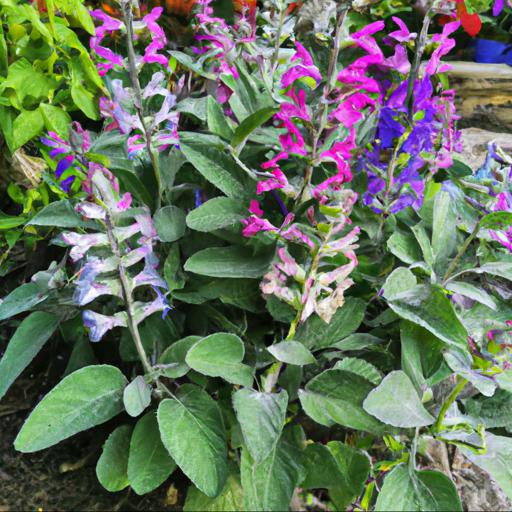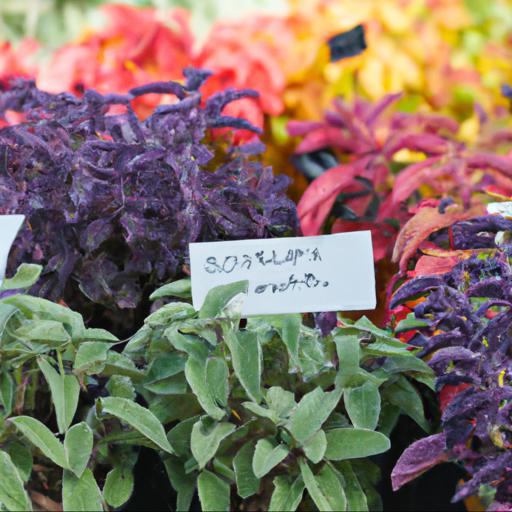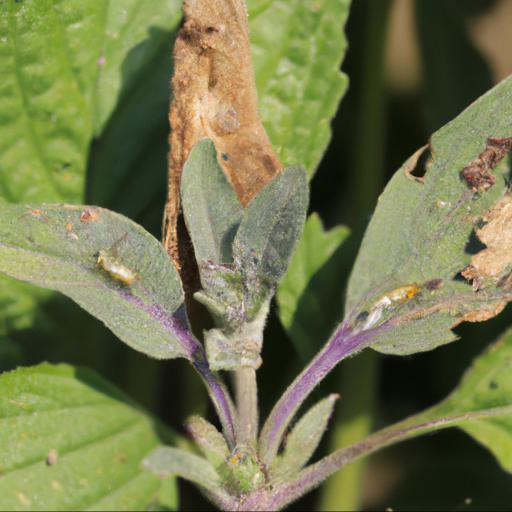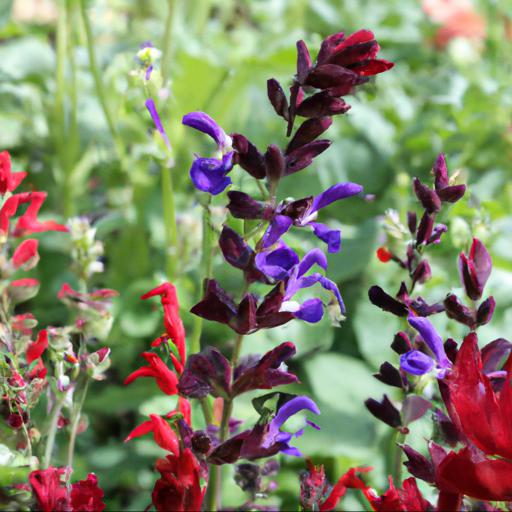Salvia officinalis tricolor, commonly known as tricolor sage, is an attractive and easy to grow herb. It is a member of the mint family and is native to the Mediterranean region.
The leaves of Salvia officinalis tricolor are a beautiful combination of green, white and purple, giving the herb its common name. It is an ideal herb for gardeners and cooks alike, as it is both aesthetically pleasing and full of flavor. The leaves can be used in salads, sauces, and soups, and the flowers can be used as a garnish.
Salvia officinalis tricolor is a hardy herb that is easy to care for and can add a unique flavor to any dish.
Benefits of growing salvia officinalis tricolor

Salvia officinalis tricolor, more commonly known as tricolor sage, is a beautiful and versatile plant that can bring a splash of color to any garden. This perennial’s striking leaves typically feature hues of blue, purple, and white variegation and its attractive blooms attract beneficial pollinators in the summer months. Growing Salvia officinalis tricolor is easy and requires little maintenance, making it a great choice for any garden.
The most popular use for Salvia officinalis tricolor is as an eye-catching edging plant that creates a beautiful and vibrant border along patios and paths. This plant can also be grown as a bright, low-growing shrub in full sun on a mid-summer border or more widely as a ground cover plant, enabling it to spread out and enhance a garden in great numbers.
Furthermore, the blooms of this plant make an excellent addition to cut flower arrangements and can be dried to create dried flower bouquets. In addition to being incredibly visually appealing, Salvia officinalis tricolor is fairly resilient and requires minimal effort to thrive.
It’s a forgiving plant and can tolerate drought, so it needs very little watering or fertilizing to achieve optimal health. This long-lasting perennial requires a spot with well-draining soil in full sun to partial shade. Other than that, it’s an incredibly low-maintenance and simple plant to grow.
Overall, Salvia officinalis tricolor is a fantastic, hardy, and colourful plant that anyone can appreciate. Its eye-catching beauty and low-maintenance life style make it the perfect choice for any garden. From its colourful foliage to its brilliant blooms, tricolor sage brings a wonderful sense of vibrancy to any outdoor space.
Tips for growing salvia officinalis tricolor

Salvia officinalis tricolor, is a show-stopping perennial herb with vibrant foliage and a heavenly aroma. Native to Southern Europe and the Middle East, this ‘tri-coloured sage’ revels in well-draining, loamy soils and enjoys abundant sunlight and mild temperatures. With a little extra effort and TLC, this Mediterranean wonder will reward you with masses of cheerful blooms and succulent leaves year after year.
Here are some tips for growing Salvia officinalis tricolor in your garden. Firstly, when planting Salvia Officinalis tricolor, flatten the soil and ensure it is moist but not waterlogged.
This is critical for promoting proper drainage and avoiding root rot. Additionally, spacing the plants 10 inches apart will ensure they have adequate room to spread their vibrant foliage as they mature.
Next, Salvia officinalis tricolor loves bright sunlight and moderately humid conditions, but is prone to burning in direct sun, especially in the peak of summer. If your garden is located in a warm climate, partial shade provides an ideal growing environment and is usually sufficient to keep the plants healthy. It’s also important to stay on top of watering your plants.
Allow the soil to dry slightly between watering and be sure to remove any excess moisture to manage mold growth. Finally, to keep your Salvia officinalis tricolor plants in top condition, feed every two weeks with a 10-10-10 granular fertilizer (or compounds with similar NPK). This will provide the plants with the essential nutrients they need to formulate strong root systems, vigorous foliage and an abundance of stunning blooms.
Additionally, pruning away bald patches in the foliage will prevent insect and disease problems, and will allow sufficient airflow to reach the lower parts of the plant. Growing Salvia officinalis tricolor isn’t all that difficult, but with a bit of patience and the right growing conditions, you’ll be rewarded with an absolute show-stopping display for many years to come.
Common pests and diseases of salvia officinalis tricolor

Salvia officinalis tricolor, sometimes called ‘Tricolor Sage’, is an ornamental plant with bright, colorful foliage and attractive flowers. It’s an attractive addition to any garden and can be used for both culinary and ornamental purposes. While it is a hardy and easy to care for, it does require attention to prevent it from being overtaken by common pests and diseases.
The most common pests on Salvia officinalis tricolor are aphids and whiteflies. Both of these insects can cause significant damage if they become entrenched in the plant.
To prevent them from taking hold and damaging your plant, it is important to regularly inspect for these unwanted guests. If spotted, washing the plant and applying a pesticide is the best course of action to keep the problem from getting out of control.
As far as diseases go, the most common on Salvia officinalis tricolor is powdery mildew. Powdery mildew is a white, powdery looking fungus that can spread quickly, making it important to catch it early and treat immediately. Pruning away affected areas, watering in the morning and limiting the amount of direct sunlight that comes in contact with the plant are all methods that can prevent and help control the spread of powdery mildew.
For a more intensive treatment, chemical fungicides like neem oil or sulfur can be sprayed on the plant, making sure all plant surfaces are reached. Salvia officinalis tricolor is a beautiful addition to any garden and it is easy to ensure a healthy and thriving plant with a bit of attention. With proper planting, regular inspection and quick action when needed, Salvia officinalis tricolor can be a hardy and stunning addition to any landscape.
How to harvest and store salvia officinalis tricolor
Harvesting and storing salvia officinalis tricolor requires special attention, as this species of salvia is particularly sensitive to temperature and humidity. Salvia officinalis tricolor is one of the most popular and colorful varieties of salvias grown in gardens across the UK.
This plant grows best in well-drained soil, with plenty of sun and minimal shade. It produces long, slender stalks that reach up to 90 cm in height and produce stunning white, blue, and purple flowers from late summer into fall. Harvesting salvia Officinalis tricolor is best done when the flowers are just beginning to open and the foliage starts to yellow.
Once harvested, the stems should be cut 10 to 15 cm below the flowers and the top of the plant should be pinched off. It is important to take care not to damage the foliage when harvesting as this can inhibit future growth. Once harvested, it is essential to store Salvia officinalis tricolor in a cool and dry place, away from direct sunlight.
It is important to ensure that the plants do not get exposed to temperatures that are too hot or too cold, as this can cause the plants to deteriorate quickly. The stems should be placed in a container with water to help keep them hydrated and fresh.
It is also important to change the water regularly to prevent the stems from decaying prematurely. If you wish to store the harvested salvia for an extended period of time, it can also be dried by hanging it upside down in a warm, dark and dry location.
Harvesting and storing Salvia officinalis tricolor carefully and conscientiously will help ensure its continued display in your garden for many seasons. With a bit of attention and care, this stunning plant can be enjoyed for many years.
Our video recommendation
Bottom Line
Salvia officinalis tricolor is a beautiful and unique variety of sage that stands out with its vibrant, multi-colored foliage. It is an easy-to-grow perennial that is low maintenance and can be used in the garden to add color and texture.
This plant is drought-tolerant and can thrive with minimal care. Salvia officinalis tricolor is a stunning addition to any garden, providing a bright and cheerful display of color that will last for years.
FAQ
What are the benefits of Salvia officinalis tricolor?
The benefits of Salvia officinalis tricolor include its ability to reduce inflammation, improve digestion, boost the immune system, and reduce stress. It is also known to have anti-bacterial and anti-fungal properties, and may help to improve skin health. Additionally, it is known to have antioxidant properties, which may help to protect against free radical damage.
How is Salvia officinalis tricolor used in cooking?
Salvia officinalis tricolor is commonly used as a culinary herb in cooking. It has a mild flavor and can be used to season soups, stews, salads, and other dishes. It can also be used to garnish dishes, as a garnish for drinks, or as a decorative element in salads.
What is the scientific name for Salvia officinalis tricolor?
The scientific name for Salvia officinalis tricolor is Salvia officinalis ‘Tricolor’.
How does Salvia officinalis tricolor differ from other varieties of sage?
Salvia officinalis tricolor is a variety of sage that is distinguished by its unique three-colored foliage. The leaves are a combination of green, white, and purple, giving the plant a distinct look compared to other varieties of sage.
What is the optimal growing environment for Salvia officinalis tricolor?
The optimal growing environment for Salvia officinalis tricolor is one that is sunny and well-drained, with a soil pH of 6.5-7.5. It prefers temperatures between 65-75°F (18-24°C) and should be watered regularly.
What are the medicinal properties of Salvia officinalis tricolor?
Salvia officinalis tricolor has many medicinal properties, including anti-inflammatory, antiseptic, anti-fungal, anti-bacterial, and anti-viral properties. It is also known to have antioxidant, anti-diabetic, and anti-cancer properties. It is used to treat a variety of conditions, such as colds, flu, digestive issues, skin problems, and respiratory issues.

